MIKROGEN recomBlot EBV IgG recomBlot EBV IgM/IgA Epstein ...
MIKROGEN recomBlot EBV IgG recomBlot EBV IgM/IgA Epstein ...
MIKROGEN recomBlot EBV IgG recomBlot EBV IgM/IgA Epstein ...
You also want an ePaper? Increase the reach of your titles
YUMPU automatically turns print PDFs into web optimized ePapers that Google loves.
E<br />
<strong>Epstein</strong>-Barr Virus<br />
<strong>MIKROGEN</strong><br />
molekularbiologische Entwicklungs-GmbH<br />
Western blot<br />
<strong>recomBlot</strong> <strong>EBV</strong> <strong>IgG</strong><br />
<strong>recomBlot</strong> <strong>EBV</strong> <strong>IgM</strong>/<strong>IgA</strong><br />
Immunoblot test with antigens produced by recombinant techniques for the detection<br />
of <strong>IgG</strong>, <strong>IgM</strong> and <strong>IgA</strong> antibodies against the <strong>Epstein</strong>-Barr virus (<strong>EBV</strong>).<br />
The <strong>Epstein</strong>-Barr virus, an ubiquitously occurring herpes virus, can cause the symptoms<br />
of infectious mononucleosis (Pfeiffer´s disease) on primary infection. Moreover, as a<br />
result of the lifelong persistence of this pathogen, reactivations can occur, especially<br />
in immuno-incompetent persons.<br />
Due to the diversity of symptoms caused by primary infection or reactivation and their<br />
correspondence with the symptoms of other diseases, one of the main tasks in routine<br />
diagnosis is the serological detection of a primary infection, past infection or possible<br />
reactivation. For this purpose, a series of individual determinations (EIA and IFT) are<br />
generally carried out for the particular class of antigen and type of antibody.<br />
The Western blot technique allows, at a glance, the detection and identification of <strong>IgG</strong>,<br />
<strong>IgM</strong>, and <strong>IgA</strong> antibodies against various classes of antigens. The application of highly<br />
specific and characteristic <strong>EBV</strong> proteins is made possible by the use of antigens<br />
produced by genetic engineering.<br />
Here the antigens EBNA-1 and p18 are of major importance: Due to the fact, that anti-<br />
EBNA-1 and/or anti-p18-<strong>IgG</strong> antibodies are detected only in the case of postacute or<br />
past <strong>EBV</strong> infections (s. Evaluation), more than 95 % of the past <strong>EBV</strong> infections can be<br />
correctly identified with the <strong>recomBlot</strong> <strong>EBV</strong> <strong>IgG</strong> strip only.<br />
React. Control<br />
gp 250/350 (MA)<br />
p54 (EA)<br />
p72 (EBNA-1)<br />
p138 (EA)<br />
p23 (VCA)<br />
„The combination of p18 and EBNA-1 (in <strong>IgG</strong> detection) represents a so far unrivalled degree of<br />
certainty in the exclusion of primary infections ...“<br />
Prof. Dr. G. Bauer, Freiburg ‘99<br />
p18 (VCA)<br />
n Product Advantages<br />
• Recombinant antigens, therefore:<br />
➣ High sensitivity and specificity<br />
➣ Easy and clear interpretation due to easy to read bands<br />
➣ No interference by anticellular antibodies<br />
• Easy test procedure; automation possible<br />
• Safe evaluation due to control sera and control strips<br />
• Separate detection of <strong>IgG</strong>, <strong>IgM</strong> and <strong>IgA</strong> antibodies<br />
• Screening of different anti-<strong>EBV</strong> antibodies in a single approach<br />
• CE label: The <strong>recomBlot</strong> <strong>EBV</strong> tests meet the high standard of the EC directive 98/79/EC on<br />
in vitro diagnostic medical devices<br />
• More than 95 % of the past <strong>EBV</strong> infections are correctly identified with the <strong>recomBlot</strong> <strong>EBV</strong> <strong>IgG</strong> strip only<br />
n Recombinant <strong>EBV</strong> Antigens used in the Test<br />
<strong>EBV</strong> antigen group<br />
Abbreviation<br />
Recombinant<br />
antigen<br />
Size of rec. antigen<br />
Membrane<br />
antigen<br />
MA<br />
gp250/350<br />
70 kDal<br />
" Early antigens"<br />
EA<br />
Virus<br />
capsid / structural antigen<br />
VCA<br />
p54<br />
p138<br />
p23<br />
p18<br />
54 kDal<br />
40 kDal<br />
23 kDal<br />
18 kDal<br />
Nuclear<br />
antigen<br />
EBNA-1<br />
p72<br />
45 kDal
n Test Principle and Procedure<br />
1 st. Incubation: A test strip loaded with <strong>EBV</strong> antigens is incubated with diluted<br />
serum or plasma in a dish for 3 h.<br />
Wash 4 times<br />
E<br />
E<br />
E<br />
2 nd. Incubation: Peroxidase conjugated anti-human antibodies (<strong>IgG</strong>, <strong>IgM</strong> or <strong>IgA</strong><br />
specific) are added. Incubate for 1 h.<br />
Wash 4 times<br />
3 rd. Incubation: 5 - 10 minutes after addition of the coloring solution, insoluble<br />
colored bands develop at the sites on the test strips occupied by<br />
antibodies.<br />
n Evaluation<br />
The diagnostic value of the <strong>recomBlot</strong> <strong>EBV</strong>, supplemented by the recombinant antigen p18 (VCA), was investigated in two different studies on two<br />
different collectives of sera (Table1 + Table 2). The test results supply evidence for the fact, that the addition of the p18 antigen makes it possible<br />
to estimate the <strong>EBV</strong> status of a patient in most cases with the <strong>recomBlot</strong> <strong>IgG</strong> strip only.<br />
Table 1: Normal collective (healthy students, n = 272)<br />
Serum group<br />
Number<br />
Interpretation with <strong>recomBlot</strong> <strong>EBV</strong> <strong>IgG</strong><br />
I<br />
- anti-EBNA-1 and/or anti-p18-<strong>IgG</strong> antibodies<br />
234<br />
(86 %)<br />
postacute or past <strong>EBV</strong> infection<br />
II<br />
- no<br />
a nti-EBNA-1 or anti-p18-<strong>IgG</strong> antibodies<br />
13 (5 %)<br />
III<br />
- no<br />
a nti-<strong>EBV</strong>-<strong>IgG</strong> antibodies<br />
25 (9 %)<br />
possible primary <strong>EBV</strong> infection<br />
(detection of anti-<strong>EBV</strong>-<strong>IgM</strong> antibodies recommended!)<br />
no <strong>EBV</strong> antibodies detectable<br />
(second serum probe recommended!)<br />
G roup I g p250/350 (MA)<br />
p 54 (EA)<br />
p 72 (EBNA-1)<br />
p 138 (EA)<br />
p 23 (VCA)<br />
p18 (VCA)<br />
I gG<br />
53<br />
(23 %)<br />
66<br />
(28 %)<br />
225<br />
(97 %)<br />
97<br />
(42 %)<br />
227<br />
(98 %)<br />
228 (98 %)<br />
Table 2: Sera suspicious for a primary <strong>EBV</strong> infection because of ELISA results (n = 199)<br />
Serum group<br />
Number<br />
Interpretation with <strong>recomBlot</strong> <strong>EBV</strong> <strong>IgG</strong>, <strong>IgM</strong><br />
I<br />
- no<br />
anti-EBNA-1 or anti-p18-<strong>IgG</strong> antibodies<br />
- anti-EA-<strong>IgG</strong> and/or <strong>IgM</strong> antibodies<br />
154<br />
(77 %) primary <strong>EBV</strong> infection<br />
II<br />
- anti-EBNA-1 and/or anti-p18-<strong>IgG</strong> antibodies<br />
38<br />
(19 %)<br />
postacute or past <strong>EBV</strong> infection<br />
III<br />
- no<br />
anti-EBNA-1 or anti-p18-<strong>IgG</strong> antibodies<br />
- no<br />
anti-EA-<strong>IgG</strong> and/or <strong>IgM</strong> antibodies<br />
- no<br />
anti-<strong>EBV</strong>-<strong>IgG</strong> and <strong>IgM</strong> antibodies<br />
7 (4 %)<br />
borderline or atypic band pattern or no <strong>EBV</strong><br />
antibodies detectable<br />
(second serum probe recommended!)<br />
G roup I g p250/350 (MA)<br />
p 54 (EA)<br />
p 72 (EBNA-1)<br />
p 138 (EA)<br />
p 23 (VCA)<br />
p18 (VCA)<br />
I gG<br />
5 (3 %)<br />
111<br />
(72 %)<br />
0 137<br />
(89 %)<br />
83<br />
(54 %)<br />
0<br />
I gM<br />
99<br />
(64 %)<br />
97<br />
(63 %)<br />
2 (1 %)<br />
118<br />
(77 %)<br />
54<br />
(35 %)<br />
91 (59 %)<br />
n Storage and Shelf Life<br />
At 4 °C 18 months from the time of production<br />
n Commercial Product Article No. 4502 <strong>recomBlot</strong> <strong>EBV</strong> <strong>IgG</strong><br />
Reagents for 20 determinations<br />
Article No. 4503<br />
<strong>recomBlot</strong> <strong>EBV</strong> <strong>IgM</strong>/<strong>IgA</strong><br />
Reagents for 20 determinations<br />
<strong>MIKROGEN</strong> GmbH<br />
Floriansbogen 2-4 · D-82061 Neuried · Germany · Tel.: +49 (0)89 54801-0 · Fax: +49 (0)89 54801-100<br />
Internet: www.mikrogen.de · eMail: mikrogen@mikrogen.de<br />
pirbebe004a




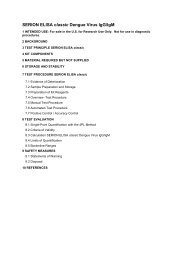
![MIKROGEN recomBlot CMV IgG [Avidity] recomBlot CMV IgM ...](https://img.yumpu.com/47840028/1/185x260/mikrogen-recomblot-cmv-igg-avidity-recomblot-cmv-igm-.jpg?quality=85)
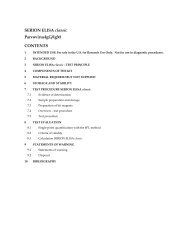
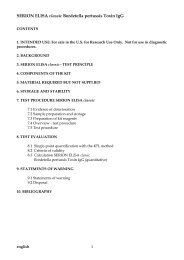
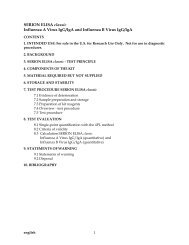

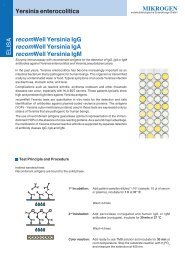
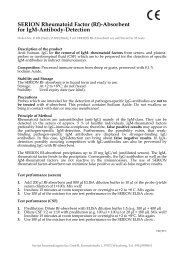

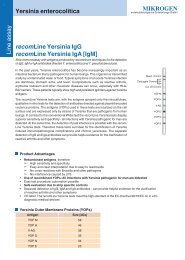
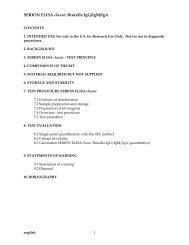

![MIKROGEN recomLine Parvovirus B19 IgG [Avidity] recomLine ...](https://img.yumpu.com/31102785/1/185x260/mikrogen-recomline-parvovirus-b19-igg-avidity-recomline-.jpg?quality=85)